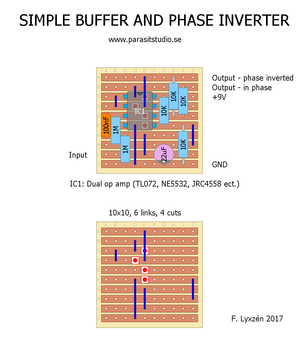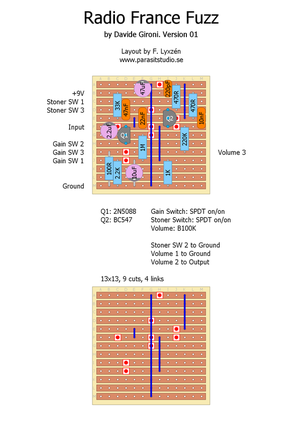|
I've seen alot of people wanting microcontroller-free relay bypass boards. There's a few designs out there, but most of them seem overly complicated, so I designed this one. It uses two 2N3904 as a simple switch flip flop and debouncer. It's not perfect (the occasional mistrigger happens) but overall it works pretty well for such a simple design. :) I'm selling a Relay Bypass PCB in the shop for an improved version (with solid debouncing) with a smaller size than the vero version. Check it out. :)
12 Comments
Here is a small utility board - a simple buffer followed by a phase inverter. You can take the output from either stage. It can be very useful if you are adding a clean blend to a circuit that is inverting the phase. I recommend putting this in front of your main effect, but keep in mind that not all effects will respond the same with a buffer in front. I didn't include polarity protection, DC filtering and an output capacitor since this is meant to be used together with another effect (not stand alone).
Here's a cool auto wah from Robert Penfold that can sound really funky and bubbly. In the soundclip the resonance and depth are maxed. I have adapted it for true bypass and added a volume pot since the output was alittle bit above unity. The controls are a bit finicky, especially the frequency controls that goes from low (so low that it kills the signal) to above the hearing range. I think a log pot work better here. I used a 2M resistor insted of the 1.8M and a BC108B transistor with good results. The 10K trimpot sets the input for the envelope follower. Adjust it until it sounds good and you get a "natural" sounding release.
This is Jon Patton's adaption of the Tube Driver, but it uses a JFET insted of a tube. It also has a few extra goodies thrown in such as an 18v chargepump and a mids switch. This circuit sounds very good IMO and has excellent controls and a wide range of tones. Thanks to Jon for sharing his work!
Edit 2015-06-12. Layout updated and verified. Here is a great sounding silicon fuzz made by Davide Gironi. Original thread here. Edit 2015-06-12. Updated the layout slightly to match the latest schematic. Anode of D7 moved down two rows. Here is another very nice compressor / overdrive. This one is a brand new creation from Sam Hay, the inventor of the Cherub Chorus that I posted a layout for earlier. Read more about it in the original thread here. For schotty diode I used a 1N5817 in my build with good results.
Here is an old circuit from Elektor, a dirty compressor and distortion in one. I was surprised that this one actually sounds really nice. The compression goes from fairly clean and subtle to very compressed and dirty. The distortion isn't bad either. :) I didn't have a BF256C, so I tried both a 2N5457 and a BF245B insted with good results. Just keep in mind the pinout.
Here is another nice PT2399-based chorus, a bit similar to the Dimension P chorus I posted earlier, but uses a single delay chip insted of two.
Another CD4007 based circuit. I was hoping this one could deliver some cool sounds. However, I found that many settings of the rotary switch doesn't sound very useful and the overdrive is lacking.
|
vero layoutsAll the layouts are Verified unless noted. Archives
February 2018
Categories
All
|











 RSS Feed
RSS Feed